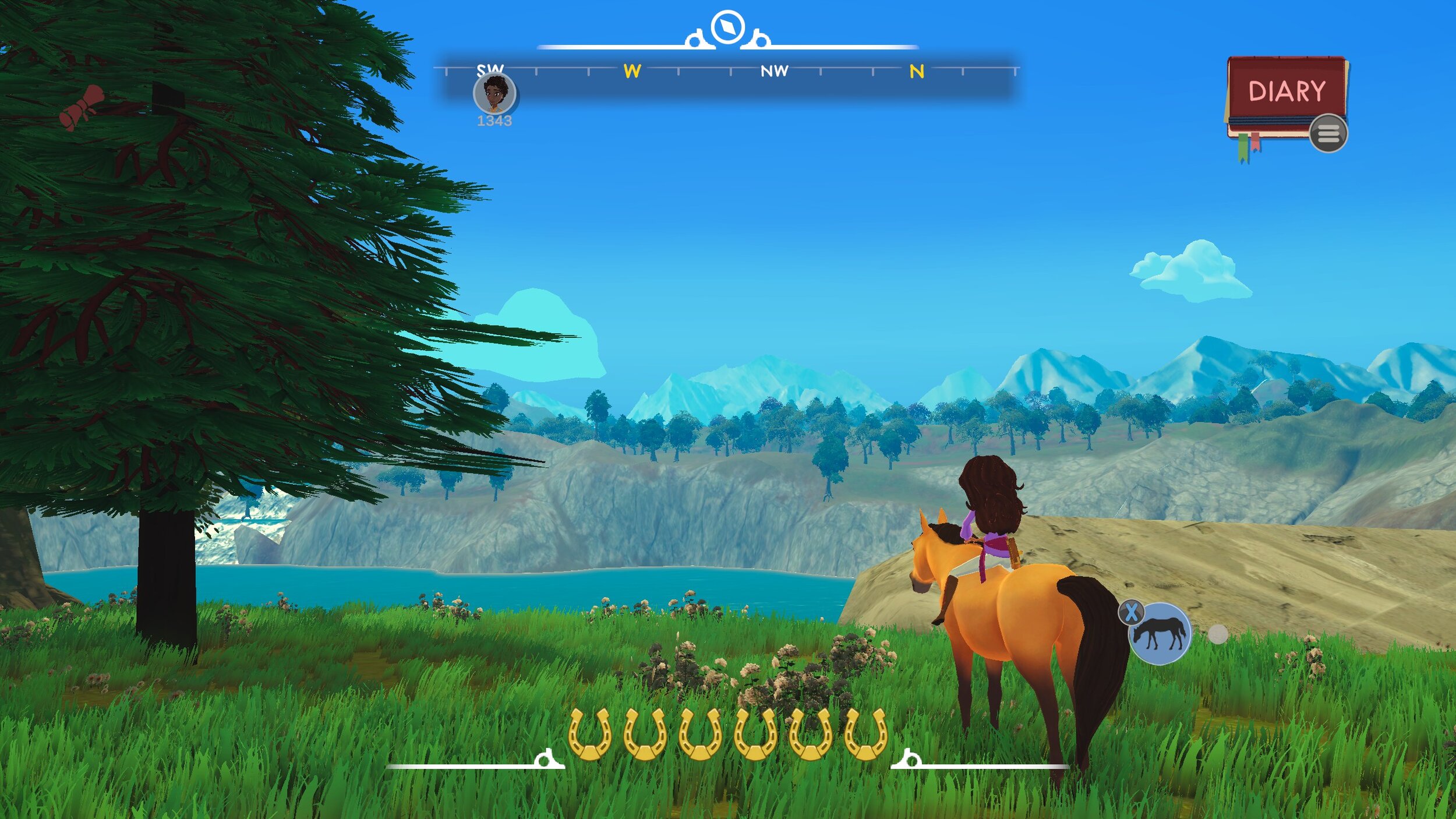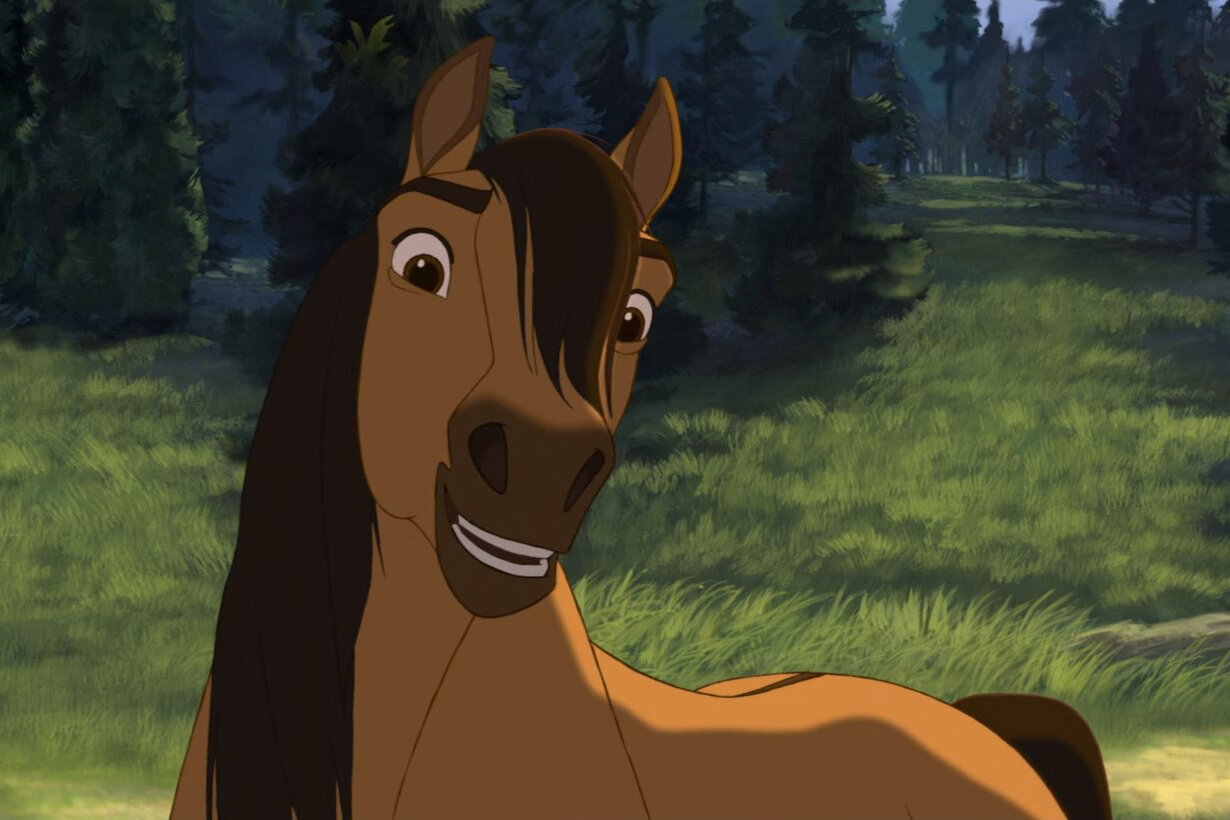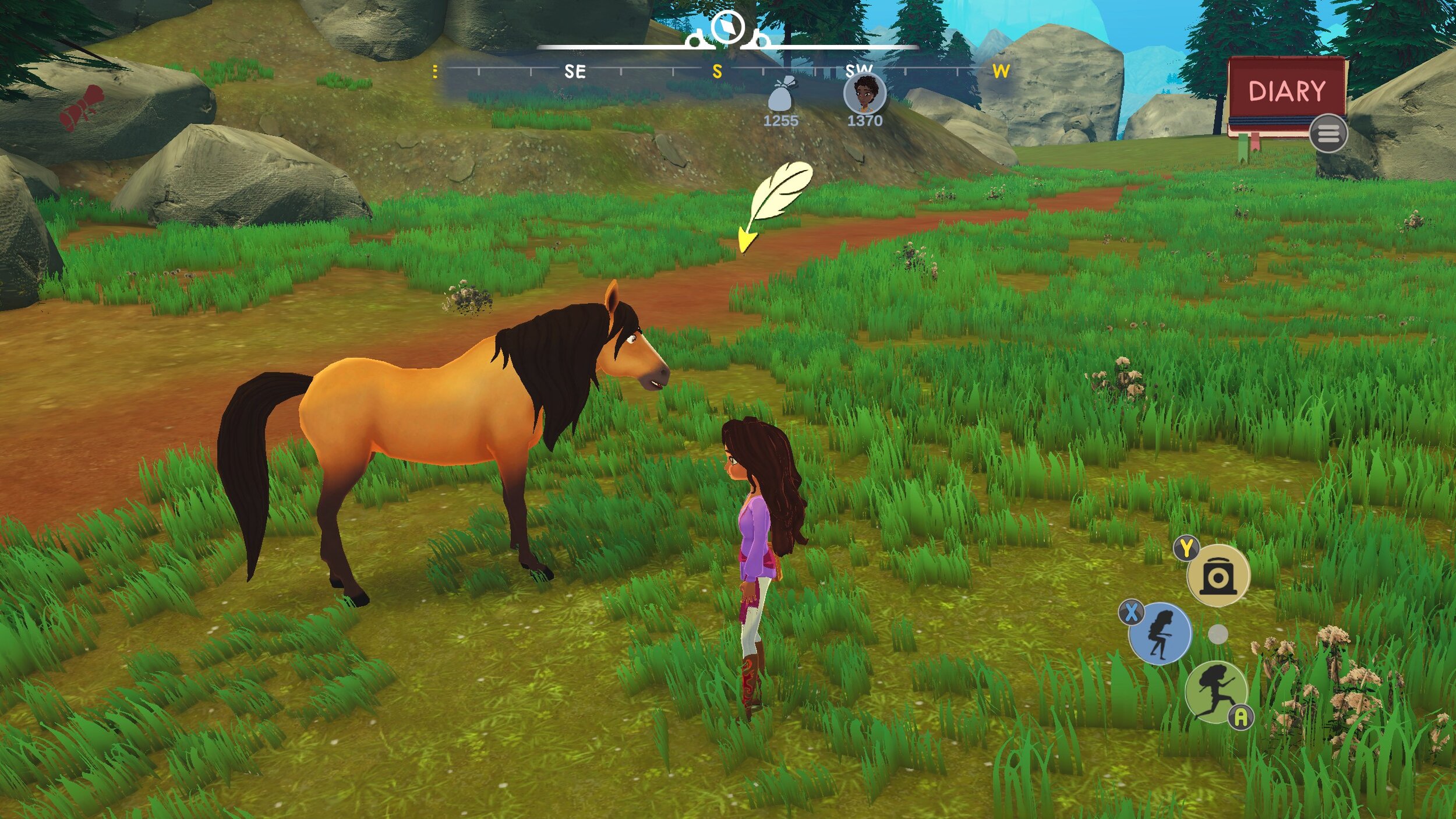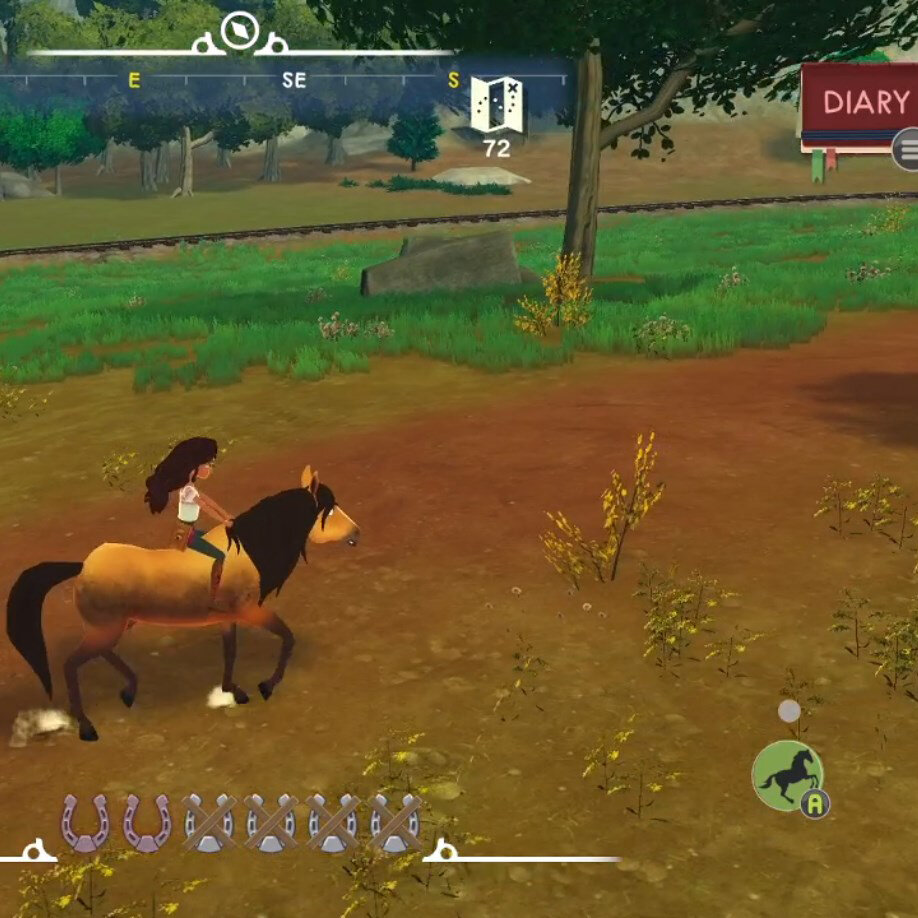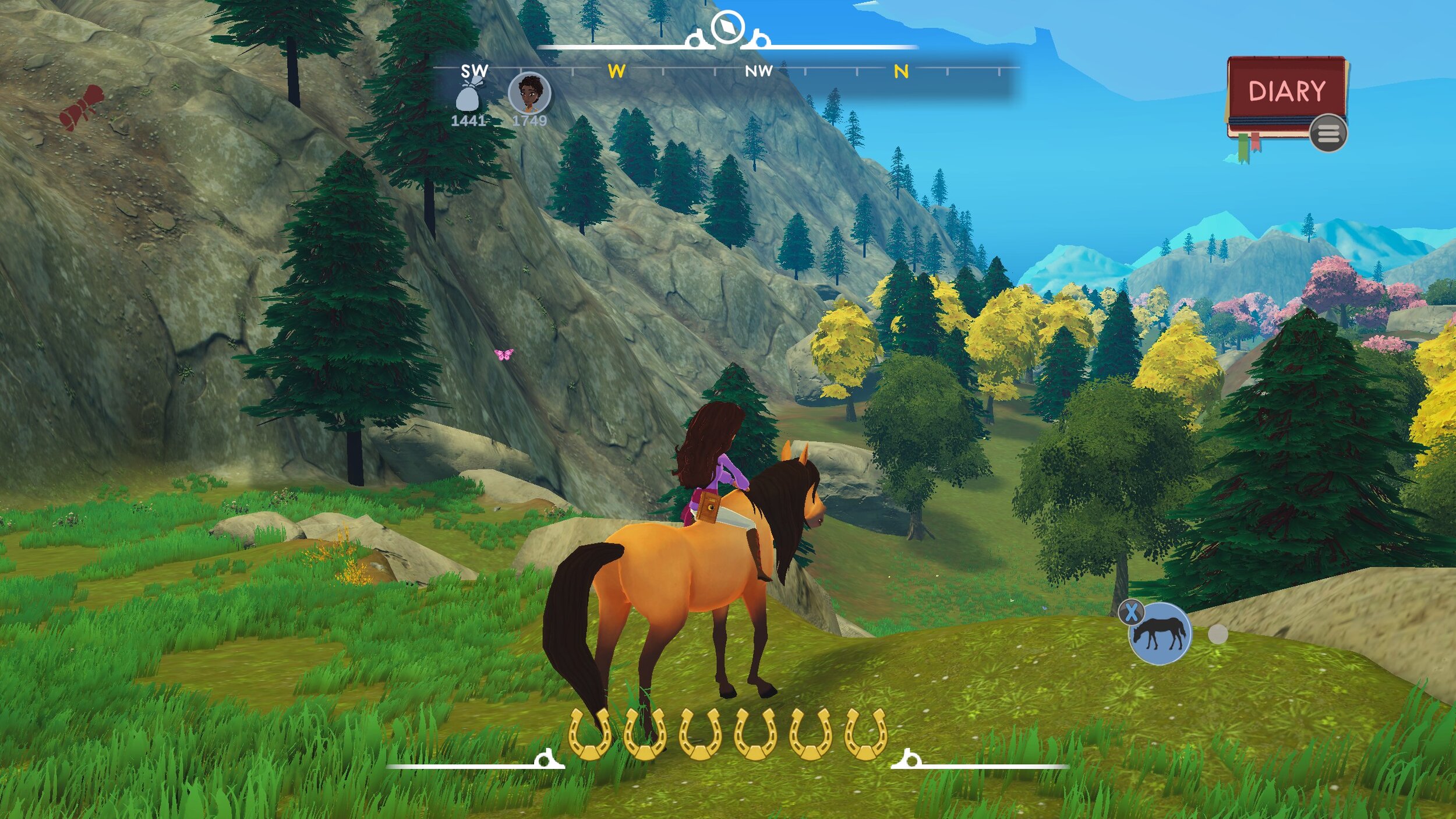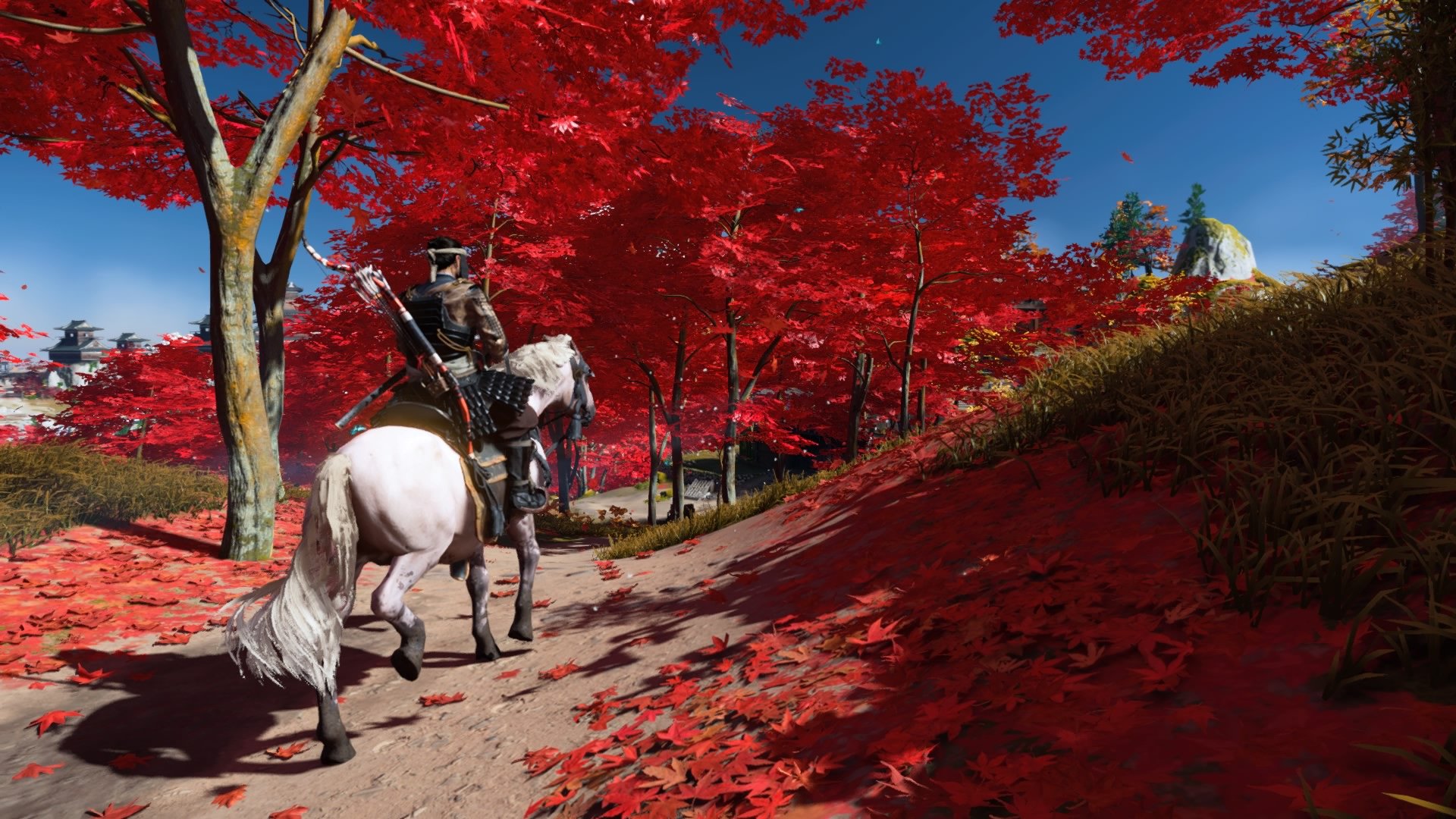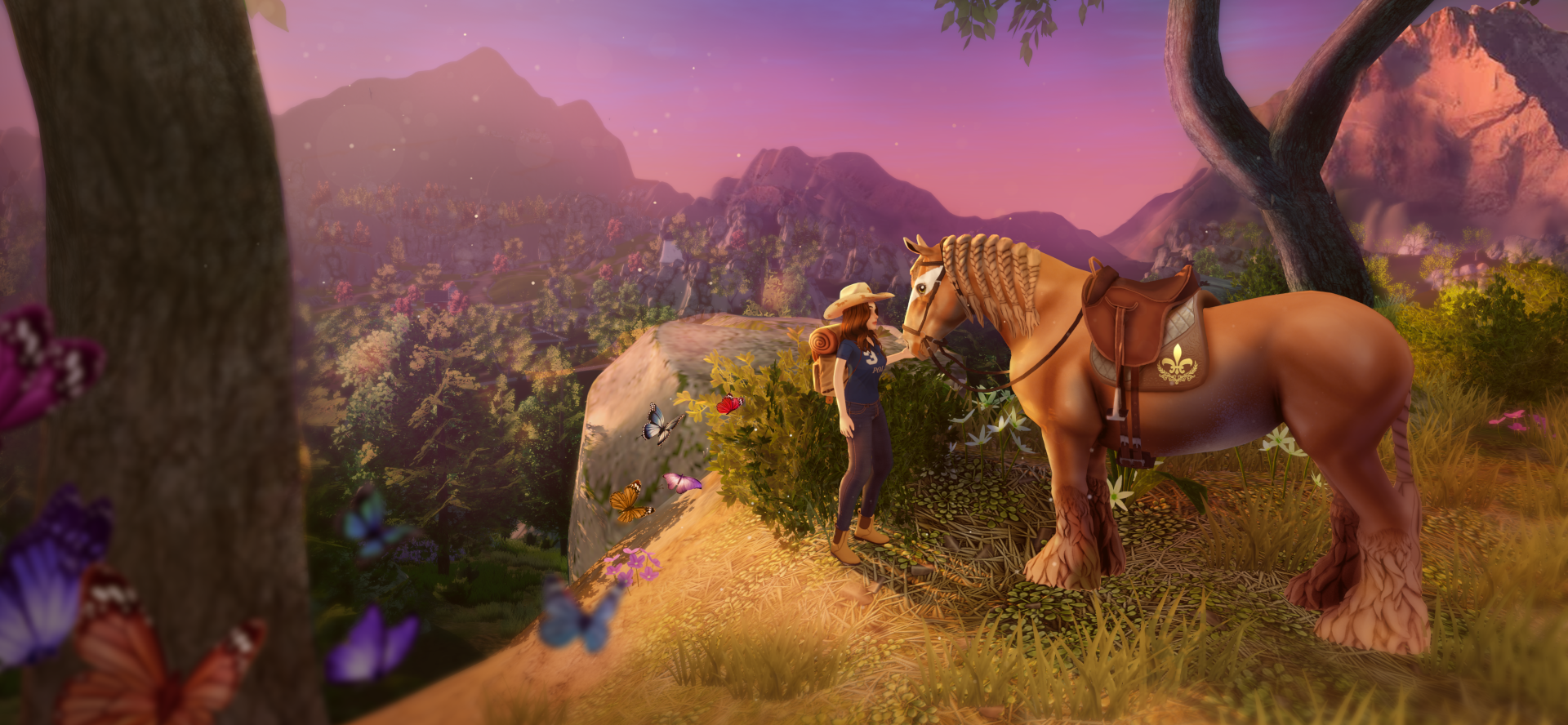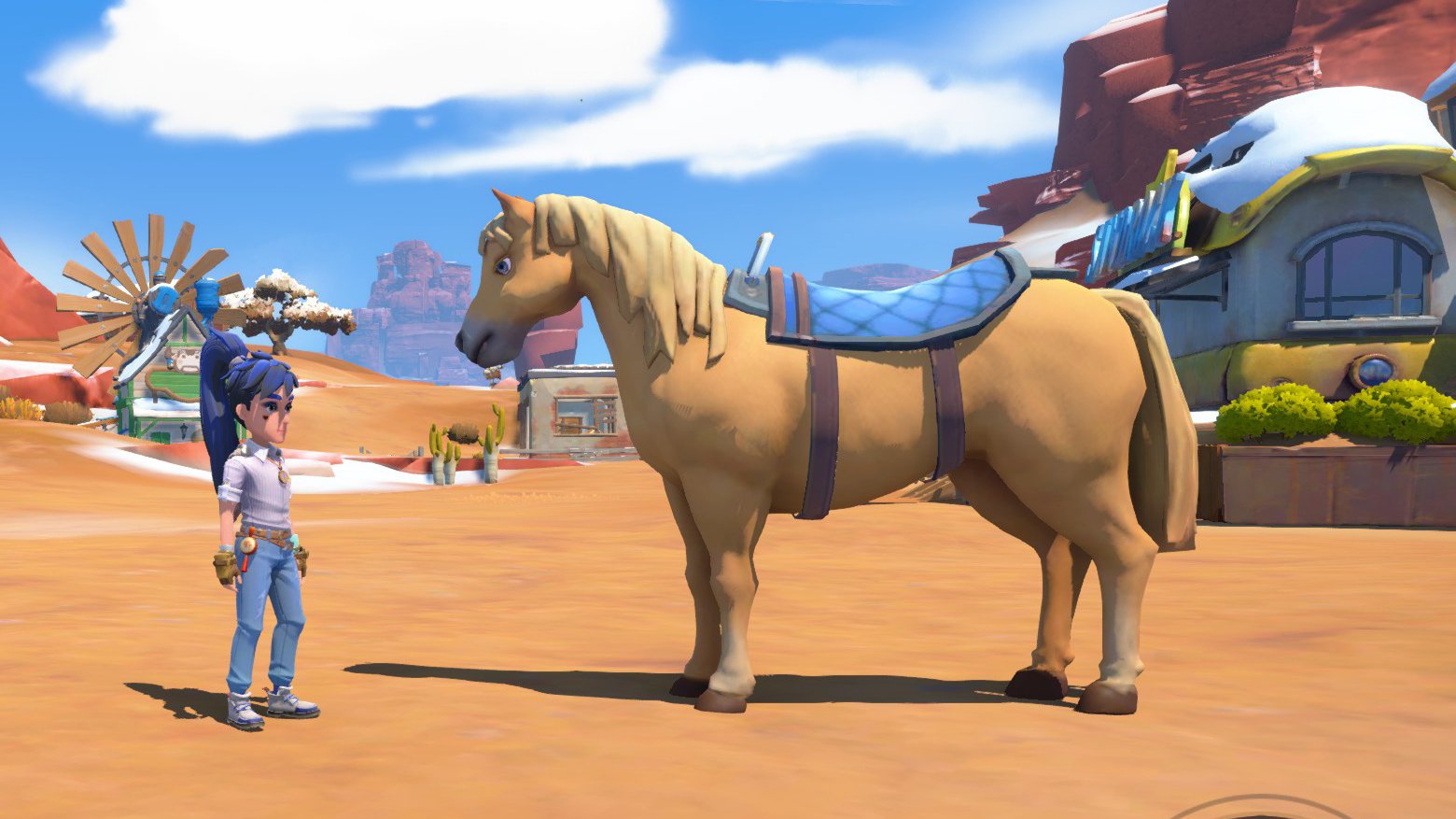Review: DreamWorks’ Spirit Lucky’s Big Adventure – A Promising Open World Game marred by a Thoroughly Frustrating User Experience
After some years of relative horse game drought, it’s quite astonishing that in Spring 2021, we got not one, but two moderately big horse games based on existing brands but with original worlds and gameplay. DreamWorks Spirit Lucky’s Big Adventure – yes, that’s the actual full title but I’ll just call it Spirit from now on thank you – and Horse Club Adventures have enough similarities that a comparison between the two can hardly be avoided: Both are story based open world games with established characters and settings, and both differ significantly from many horse games of recent years in both budget and gameplay.
You already know I was quite fond of Horse Club Adventures despite some obvious flaws, so how does this one compare? Could it be that we get two decent horse games in such a short time – or is there a clear cut decision here for which to play and which to avoid?
Before we begin, a word on the Spirit franchise: Yes, literally everyone who liked the 2002 movie Spirit: Stallion of the Cimarron would have preferred a game in the original movie’s uh- spirit over a game based on its more recent TV series and movie.
Believe me I too have various opinions on how this franchise went from being told from the perspective of a wild horse and a young native, having the US military as the unambiguous villain and being obviously critical of westward expansion and its impact on nature and people to a TV series about the daughter of a literal railroad constructor with none of the critical themes of its predecessor.
OG Spirit: 2D animated, no blaze.
Untamed/Riding Free Spirit or “Spirit Jr”: 3D, weird fuzzy coat hair rendering, white blaze
That is a rant for another day though. The franchise’s overall direction is no doubt decided by DreamWorks itself and is not something we can really call the game’s developer or publisher out for. For now, let me examine this new Spirit game for what it is rather than what we might have liked it to be, let’s judge it on its own merits. Because believe me there is plenty to say on that alone.
The Horses
I already described the first hour of the game in quite some detail in my preview article, so I will just refer you to that one for a step by step of first impressions.
Here I’ll start with what I didn’t have the time to look at in detail during the preview: the horses and their animations. Now, I know making games is hard and so is animating horses, but oh boy the look of Spirit and his herd is rough.
The horse model is wobbly and sway-backed, has a gigantic neck and got its forelegs bent in all the wrong moments, which is quickly becoming my number one most common horse animation complaint. Some of the cartoonish stylization such as Spirit’s comically large neck, broad head and narrow ear placement is unfortunately to be expected of the franchise these days. In terms of movement however, the Spirit game model looks noticeably worse compared to Riding Free and Untamed. Judging by the rearing animation seen in some cutscenes, the horse animations are (at least partially) based on the ever-present and unfortunately still very flawed Horse Animset Pro, which… explains a lot I suppose.
The transition from neck to back is all messed up. On a real horse, this would be a conformation flaw called mutton withers.
The head and face shape are pretty close to how Spirit looks in the Untamed movie, so I can’t really bash the game for that but wow do I dislike it.
Like Horse Club Adventures, DreamWorks Spirit Lucky’s Big Adventure does not let the player move at a consistent walk or trot unless you carefully push the joystick very softly. All the gaits are there, but have odd blend-states between them instead of proper transitions, making slow movement incredibly awkward. The forelegs never stretch out far enough for the motion to look right and the canter animation has both legs going forward at the same time sometimes. This and many other details result in a motion style that is just not particularly horse-like.
The walk motion looks disjointed.
At the trot, the front legs stay bent the whole time instead of stretching forward.
This rearing animation is what gives it away as HAP-based. Which is not inherently bad, but explains why all these common flaws are there.
The canter animation looks alright sometimes, but then does this weird thing with the simultaneous foreleg motion.
I appreciate that the fetlocks bend the right way at a walk and I like the cartoonishly solid mane and tail, so that’s nice. Another few words of praise go to the coat color variety among the herd and the fact that they lay down to doze when left alone. But overall the stylization just removes everything that I generally like about horses.
I usually try to be more precise than that, but all these horses just don’t look good to me.
The stylization is just really unfortunate.
At the home stable, Lucky can groom Spirit to recharge his sprinting capacities, which are represented by horseshoe icons. This is rather ironic considering that as a mostly feral horse, Spirit does not wear horseshoes. The sprint capacity recharges automatically if used up, but individual horseshoes are eventually ‘locked’, which means it’s time to return to the home stable for grooming.
Grooming consists of brushing the dirt off Spirit’s coat, making the choice to represent this using horseshoes even less fitting. At least the dirt is also visible on Spirit’s coat, with a dirt texture that gets an honorable mention for actually looking like dirt, unlike some examples we’ve seen on this site.
The grooming mechanic itself is perfectly fine, and gains some originality points by actually showing you Lucky’s character model, rather than letting you control a floating brush as every other horse game does it. The general idea of “optional grooming if you want to sprint” is also solid.
The concept utterly falls apart in practice however: in my playthrough, the grooming often became necessary just as I was out on a long mission and far away from the home stable. Although fast travelling back to the stable is an option, it means losing a lot of progress if you haven’t reached a new fast travel location yet where you’re currently at.
When your sprint capacity is just depleted (not locked), you have the option to recharge it by hugging Spirit: This is a very cute idea, but having to stop and dismount right in the middle of trying to get somewhere fast feels frustrating enough that it makes way more sense to just continue at a canter rather than taking a break to recharge the sprint.
And I haven’t even started on the sprint itself: when I first tried the game for the preview, I first thought sprinting was broken or buggy because I couldn’t get it to work. When you tap the sprint button, one of your sprint horseshoes starts blinking, indicating that it’s being used. To actually keep the sprint active however, you need to hold the button. The horseshoe is used up regardless of whether or not you actually keeps sprinting. I’m picking at the details here, but I’m illustrating all these weird points of friction in order to show how many aspects were not properly thought through and were not reexamined for their usability and intuitive use.
And this brings me to my next point: It’s not just the sprinting. The entire user experience of DreamWorks’ Spirit Lucky’s Big Adventure is pretty damn bad.
Controls and UX
Note the button on the bottom right: it shows a rearing horse, but is used for jumping.
This may just be me but I found the compass icons not intuitive at all.
Where to even begin. In a game where I’m encouraged to travel on horseback 90% of the time, having to dismount to talk to a character is really annoying. The game was released on PC but doesn’t officially support keyboard & mouse to play. Many of the icons on map and compass make no sense: why is there a feather above Spirit when I can mount him, for example? In the photo album menu, I have to use my joystick to navigate to the “next page” button instead of making use of the controller’s shoulder buttons. The jump button icon shows a rearing horse instead of a jumping one. The icon to open doors looks like a settings icon. When starting the game I am back at the home stable regardless of where my last mission ended. I don’t have a button to brake or stop while riding, so I have to accurately gauge my braking distance upon letting go of the stick, or else I constantly run into buildings and characters.
All of these details would be much easier to forgive if the horse riding itself felt good. Unfortunately, it does not. Riding across open plains is fine, but as soon as you’re navigating between rocks or buildings, it’s very easy to accidentally run into things and even get stuck on them. As established, maintaining a slow speed is practically impossible, so I ended up constantly cantering into things. And I am an able-bodied adult with some gaming experience; I’d wager this issue is worse for the kids the game actually targets.
Another massive source of annoyance for me was the waypoint guidance system: Spirit has an open world, but instead of giving you a goal to reach, you only ever see the next waypoint to guide you there. This has its merits in terms of nudging the player along routes that make sense, but it also completely removes any sense of “exploration” from the main missions – a rather damning fault for an open world game.
The game has fast travel points to reduce the tedium of retreading already explored paths, but more often than not you’ll have to follow the waypoints anyway because the game doesn’t tell you where the actual target location of your current mission is. Regardless of movement speed, the waypoints only disappear and update once they’re already behind you, adding a lot of noise to your compass and generally impeding orientation.
The path is not clear in advance, you can’t brake quickly and I was stuck in that box’ collider afterwards. Lovely combo.
Visible here: waypoints disappearing too late, icon jumping around on the compass
It’s even worse when the waypoints lead across the wilderness rather than along a road, because then it often happens that you ride past a waypoint, suddenly don’t see the next one, and realize too late that you should have actually taken a turn somewhere, but since the waypoints only ever disappear behind you it’s impossible to plan ahead for that.
All of this screams of a lack of iteration and consideration in the dev process, which I suspect was limited by a budget simply not suited to the task, as we’ve seen in time and time again in this genre.
Lucky’s Adventures
The game’s story focuses on Lucky finding a treasure map that was left to her by her late mother and following the map and a poem to find the promised treasure. On this quest, Lucky and her friends Pru and Abigail soon run into the villainous Hendricks, who likes to go around stealing things and capturing wild horses. I can’t really judge the overall quality of adaptation between tv show, new movie and game, but I can tell that Abigail’s dialogue is very Abigail, and I do appreciate that.
The story beats – including the dynamics between the girls and the villain – are very kid-friendly and goofy, but they work in that context. Although some of the story is told through voice overs and dialogue boxes, the game also features plenty of animated cutscenes that give it a significantly more cinematic feeling than competitors like Windstorm: Ari’s Arrival or Horse Club Adventures.
Unfortunately however, the lack of polish and iteration is noticeable in the story too. Various quest setups confused me by coming out of nowhere, as unvoiced cutscenes and explanatory dialogue are kept entirely separate.
Late in the game, there’s a quest to find berries to get past a bear. On my way to the berries I had my path blocked by another bear who I assume was there randomly, so I snuck past it in order to find the berries to distract the other bear in my path with.
She calls the ice tricky, but then it turns out you just have to find a coat because it’s cold.
Some of the worst offenders are wolves showing up to block your path “into the forest” even though your latest quest didn’t indicate you having to go into a forest at all, or your quest goal turning into “find a new path” after the first path you try has… some ice on the side? There’s really just some stuff missing between the text boxes and animations. As a result, the whole main quest line feels rather tacked together, like the glue between the individual building blocks is missing. I would struggle to recap the story, even though not that much happened, simply because a lot of the “you have to do this now” instructions felt like they randomly came out of nowhere.
Not pictured: just after this clip, I fell down twice and had to start over of badly placed colliders and the suboptimal camera.
During the final act of the game, any impetus built up by the narrative is brought to a halt entirely when the game sends you on a three-part fetch quest to find different sorts of berries. Some unintentional hilarity arises due to Lucky’s voice line “I think this is the right path” playing whenever she’s getting close to a quest target, even if it literally leads to her own home. The main quest line has a few neat moments that I appreciate, but far too much pointless padding and nowhere near enough mechanical substance to make me overlook the issues with the game’s user experience, controls or horse animation.
Cutscenes are hindered in their fluidity by the fact that you see about five seconds of black loading screen for every ten seconds of animation. The Uncharted-style climbing mechanics are an alright change of pace but also don’t feel all that polished and fluent all in all.
Photo Mode and Other Merits
In my preview, I mentioned this game might be worth purchasing for the photo mode alone: in true Pokémon Snap fashion, you can spend your time sneaking up on wild animals and taking their pictures, as long as you make sure the animals are centered in the photo, facing you, standing still, and close enough to your position.
The animals add some much needed liveliness to the play world, and the camera is used at multiple points in the story, which is nice. Unfortunately, the animal photography itself quickly turned more frustrating than interesting after a few attempts at photographing animals and realizing that the balance between “close enough to take a valid picture” and “so close that you’ll scare it” is entirely out of whack. I really wanted to love this feature, but was soon disheartened by the lack of feedback in how to behave around animals in order to take good pictures.
The fact that the X’s rotation makes it look like a plus and that you can barely even see the red/green icons on the noisy background is another one for the “Bad UX” tally.
“Too far” are you kidding me? It ran off right after this when I tried to get closer.
Apart from the main missions, there are also a handful of side quests which seem to consist out of “go there, get that”. You can also find collectible outfits and put them on at home. The world is generally pretty enough, but my interest in exploring was severely hampered by the faulty waypoint system and the tendency for Spirit to get stuck in colliders where you don’t really expect them, and multiple frustrations in photo mode.
Playing through the story took me a total of about six hours. As I’ve mentioned on other occasions, I don’t like to judge games by the “price-per-playtime” metric because I consider the quality of an experience to be more important than the quantity. Unfortunately, Spirit ends up offering neither.
In Conclusion
I’m going to have to end this review on a resounding “meh”. DreamWorks Spirit Lucky’s Big Adventure is definitely not the worst horse game I’ve reviewed on here, but neither can I really recommend it to anyone.
Polish and consideration for the player’s experience is missing at every corner in this game, and none of its redeeming qualities are remotely good enough to get me to look past its flaws.
I said at the beginning that I would not harp on this game for not being what I would want a Spirit game to be. But as I’ve just tried to demonstrate, the game is thoroughly underwhelming even in its nature of being a tie-in game to Spirit Untamed. And man what I would not give for a Spirit game that was closer to the 2002 movie in terms of style, themes and narrative.
As it is, I can only recommend buying and playing DreamWorks Spirit Lucky’s Big Adventure if you (or your child) are a huge fan of the TV show or new movie and have a high tolerance for frustration.
Where “low budget movie tie-in horse game” goes, this one is certainly a better choice than either Bibi & Tina or Windstorm. Considering the $40 price tag however, I would say you’re better off waiting for something better, or going for Horse Club Adventures instead.
DreamWorks Spirit Lucky’s Big Adventure was released on PlayStation 4, Nintendo Switch, Xbox One and Microsoft Windows in June 2021. The Mane Quest was provided with a review copy for free.

